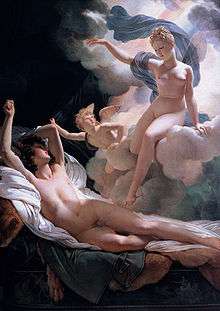Morpheus (mythology)
| Morpheus | |
|---|---|
| God of dreams | |
 Morpheus and Iris, by Pierre-Narcisse Guérin | |
| Abode | Mount Olympus |
| Consort | None |
| Parents | Hypnos |
| Children | Unknown |
| Roman equivalent | Morpheus |
Morpheus (/ˈmɔːrfiəs/ or /ˈmɔːrfjuːs/) is a god of dreams who appears in Ovid's Metamorphoses.
God of dreams and sleep
Morpheus has the ability to mimic any human form and to appear in dreams. His true semblance is that of a winged daemon, an imagery shared with many of his siblings. Robert Burton, in his 1621 Anatomy of Melancholy, refers to Classical depictions of Morpheus, saying "Philostaratus paints [Morpheus] in a white and black coat, with a horn and ivory box full of dreams, of the same colours, to signify good and bad".[1] In myth, Morpheus was also said to send dreams through one of two gates, one of ivory, and the other of horn. Starting in the medieval period, the name Morpheus began to stand generally for the god of dreams or of sleep.[2] In Carl Michael Bellman's Fredman's Epistle No. 72, "Glimmande nymf", Morpheus is invoked as the god of sleep.[3]
In Ovid
The Roman poet Ovid states in his Metamorphoses that Morpheus is a son of Hypnos and reports that he had a thousand siblings, with Morpheus, Phobetor and Phantasos being merely the most prominent among them.[4]
Derivations
- The name of the opiate drug morphine is derived from the name of Morpheus.
See also
References
- ↑ Burton (2001)(Pr. 2, Sec. 2)
- ↑ Kearns (1996)
- ↑ Britten Austin, Paul. The Life and Songs of Carl Michael Bellman: Genius of the Swedish Rococo. Allhem, Malmö American-Scandinavian Foundation, New York, 1967, pages 87–88. ISBN 978-3-932759-00-0
- ↑ Ovid (1836) p.54
Bibliography
- Burton, Robert. (2001), William H. Gass., eds., The Anatomy of Melancholy., New York, ISBN 9780940322660.
- Griffin, A. H. F. (1997), A Commentary on Ovid, Metamorphoses XI, Hermathena, 162/163, Dublin, JSTOR 23041237.
- Kearns, E. (1996), "Morpheus", in S. Hornblower & A. Spawforth (eds.), Oxford Classical Dictionary (3rd rev. ed.), Oxford, ISBN 9780198661726.
- Ovid (1836). "Book XI". Metamorphoses.
External links
| Wikimedia Commons has media related to Morpheus. |